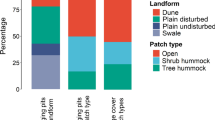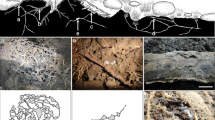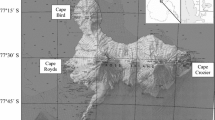Summary
We measured soil translocation due to the tunneling of valley pocket gophers (Thomomys bottae) in a Mima moundfield at Miramar Mounds National Landmark, San Diego, California, from December, 1984 through December, 1985. We placed 1-l soil plugs containing 20 11-g iron pellets into pocket gopher tunnels at locations between mound tops and points about one mound radius beyond mound edges. After about 4–10 d, sites to which the marker-containing soil had been translocated were located with a metal detector and the horizontal and vertical displacements measured. Between 1 October and 15 May (the cooler, wetter portion of the year), pocket gophers removed an average of 63% of the experimental plugs and moved an average of 38% of the markers that we recovered. From 15 May through 1 October (the hotter, drier portion of the year), only 32% of plugs were cleared and 12% of the recovered markers were moved. On average, markers that were moved were displaced 41 cm moundward and 4.9 cm upward in elevation. The intensity of moundward translocation increased with distance from the mound center. At a distance of 0.5–1.0 mound radius beyond the edge of the mound, the moundward translocation tendency averaged 71 cm. The intensity of moundward translocation was also inversely related to maximum mound height. These observations provide strong support for the fossorial rodent hypothesis of Mima mound origin, and constitute a first step in development of a mathematical model of mound formation.
Similar content being viewed by others
References
Andersen DC, MacMahon JA (1981) Population dynamics and bioenergetics of a fossorial herbivore, Thomomys talpoides (Rodentia: Geomyidae), in a spruce-fir sere. Ecol Monogr 51:179–202
Cox GW (1984a) Mounds of mystery. Nat Hist 93 (6):36–45
Cox GW (1984b) The distribution and origin of Mima mound grasslands in San Diego County, California. Ecology 65:1397–1405
Cox GW (1984c) Soil transport by pocket gophers in Mima mound and vernal pool microterrain. In Jain S, Moyle P (eds) Vernal pools and intermittent streams. Pub No 28, Institute of Ecology, Univ of Calif Davis, pp 37–45
Cox GW, Gakahu CG (1983) Mima mounds in the Kenya highlands: significance for the Dalquest-Scheffer hypothesis. Oecologia (Berlin) 57:170–174
Cox GW, Gakahu CG (1986) A latitudinal test of fossorial rodent hypothesis of Mima mound origin in western North America. Z Geomorph 30:485–501
Cox GW, Roig VG (1986) Argentinian Mima mounds occupied by ctenomyid rodents. J Mammal 67:428–432
Gettinger RD (1984) Energy and water metabolism of free-ranging pocket gophers, Thomomys bottae. Ecology 65:740–751
Lovegrove BG, Siegfried WR (1986) The distribution and formation of Mima-like earth mounds in the Cape Province of South Africa. S Afr J Sci 82:432–436
Miller MA (1957) Burrows of the Sacramento Valley pocket gopher in flood-irrigated alfalfa fields. Hilgardia 26:431–452
Richens, VB (1966) Notes of the digging activity of a northern pocket gopher. J Mammal 47:531–533
Author information
Authors and Affiliations
Rights and permissions
About this article
Cite this article
Cox, G.W., Allen, D.W. Soil translocation by pocket gophers in a Mima moundfield. Oecologia 72, 207–210 (1987). https://doi.org/10.1007/BF00379269
Received:
Issue Date:
DOI: https://doi.org/10.1007/BF00379269




